Looking to liven up your living space?
Well, as they say, look no further than spider plants!
Being indoor beauties, it is a fantastic choice to grow spider plants indoors for brightening up your home. Whether you’re a plant pro or just dipping your toes into the gardening world, spider plants are a great choice to add to your plant collection.
The reason is that the spider plants are super easy to care for and bring a delightful charm to any room. With more than 200 varieties to choose from, you’re bound to find a spider plant that suits your style and home.
In this blog post, we’ll talk about twelve different types of spider plants.
So, if you’re eager to bring a bit of green into your home, stick around!
From variegated spider plant varieties to solid green spider plants, we’ve got you all covered. You’ll definitely be able to choose a particular variegatum spider plant variety according to your own taste and style.
So, without further ado, let’s dive in!

Spider Plant | An Overview!
The spider plant, scientifically named Chlorophytum comosum, is a lovely green companion with a rich history rooted in tropical Africa. It also finds a cozy home in Western Australia, showcasing its adaptability to various environments.
What sets the spider plants apart from other plants is their sleek, arching leaves that can grow up to 18 inches long.
Spider plants come in different styles, some with striking green and white stripes, others keeping it simple with solid green. But here’s the real surprise: Sometimes, the same green-orange spider plant will produce white flowers, gracing its caretaker with tiny white blooms.
Thus adding more charm to an already captivating space. It’s like nature giving you a little bonus for your hard work!
In a nutshell, this plant is the whole package, fitting beautifully indoors and outdoors.
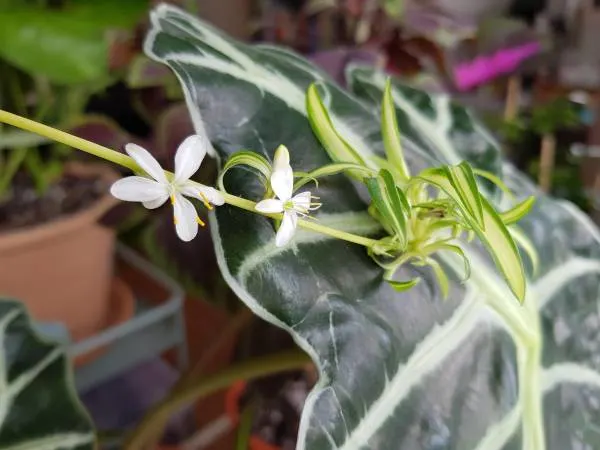
Types of Spider Plants!
There are different varieties of spider plants that offer a unique touch of green elegance to your spaces.
These captivating spider plant varieties will not only enhance your surroundings but also purify the air, turning your home or office into a vibrant haven.
Let’s discuss some common varieties of spider plants in detail.
1. Airplane Spider Plants
The Airplane spider plant is a remarkable member of the spider plant family.
What sets it apart is its distinctive curved leaves, adorned with a light green center and yellowish margins. Being a variegated spider plant, it craves attention with its subtly gorgeous appearance.
This curly spider plant is resilient and can thrive in dry conditions.
It doesn’t demand much attention, making it an excellent choice for those overlooked corners of your home.
Place it in a decorative pot, or embellish your hanging baskets with its beauty, and you’ve got yourself a low-maintenance ornamental hanging plant, that’s a win-win for any space.
Characteristics
Here are a few plant characteristics:
Size: Airplane spider plant grows up to 2-3 feet in height.
Light Requirement: This spider plant prefers to thrive in bright, indirect sunlight.
Soil Requirement: To grow well, it requires slightly acidic soil with a pH between 6.0 to 7.0.
Give your space a touch of natural beauty with the Airplane spider plant.
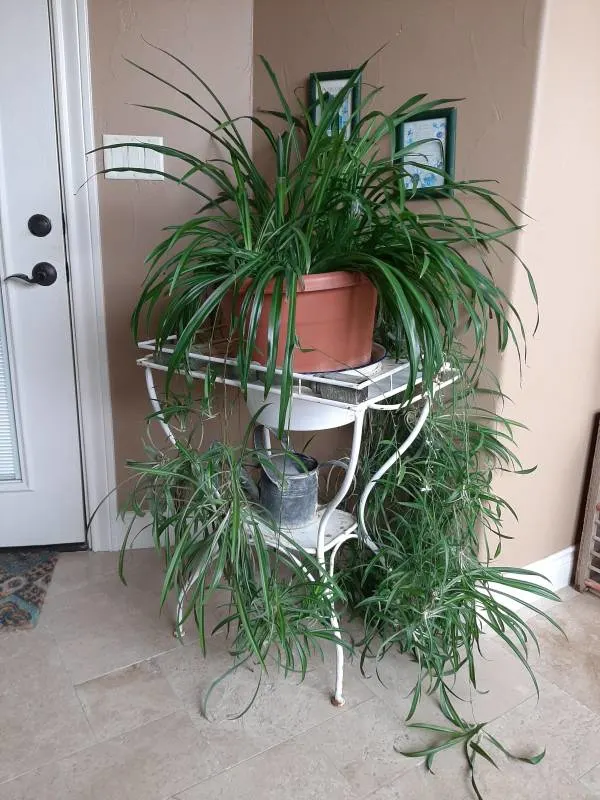
2. Atlantic Spider Plant
The captivating Atlantic spider plant traces its roots back to the enchanting landscapes of Asia and the vibrant shores of South Africa.
This charming indoor plant boasts leaves that look like delicate white ribbons edged with vibrant green, giving your space a touch of elegance.
It might even surprise you with dainty white flowers.
The good thing about this variegated spider plant is that it’s a survivor, tolerating drought, humidity, and dry shade, though a little extra care never hurts.
Characteristics
Let’s look at some plant characteristics:
Size: Its compact size, reaching between four to eight inches in height, makes it an ideal choice for any room.
Light Requirement: Whether you have bright or shady spots, it’s content as long as it’s not in direct sunlight.
Soil Requirement: It demands slightly acidic soil to grow healthy, specifically in a pH of 6.1-6.5.
Give your space a breath of fresh air with the Atlantic spider plant!
3. Bonnie Spider Plant
The variegated Bonnie spider plant is often affectionately referred to as the “curly spider plant.”
This delightful botanical wonder of a spider plant is a must-add to your collection if you are looking to spruce up your living space.
The unique green leaves of Bonnie curly spider plant plants are elegantly twisted and adorned with creamy white strips that bring a unique charm to where they are planted.
What’s even more delightful is their versatility. Whether it’s the bathroom or the heart of the kitchen, your variegated Bonnie spider plant will fit right in, effortlessly enhancing the ambiance of your space.
But wait, there’s more!
The variegated Bonnie spider plant isn’t just a beauty; it’s a plant parent’s dream come true.
The easy-care nature of this curly spider plant makes it an ideal choice for enthusiasts of all levels.
Characteristics
Here are a few plant characteristics:
Size: Bonnie spider plants don’t demand much space, as they typically grow to a modest 8-18 inches in height.
Light Requirement: These spider plants thrive in bright, indirect light or artificial light, and you only need to water them when the soil is dry.
Soil Requirement: For best results, use well-drained soil, and consider placing your spider plants in a hanging basket to add a touch of greenery to your living spaces.
So, why not bring some green goodness into your home with these twisted wonders?
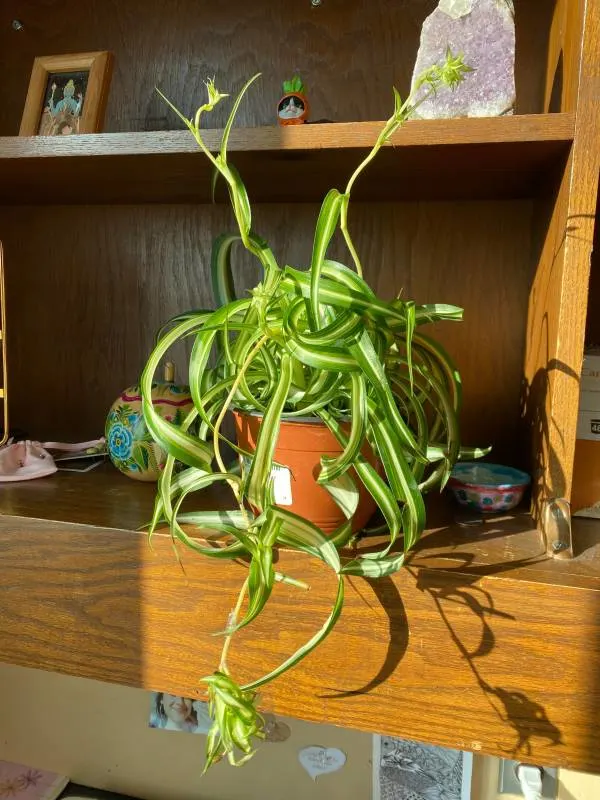
4. Bichetii Grass Spider Plant
The Bichetii spider plant, also known as Bichetii Grass, is a charming houseplant that’s much like other spider plants but has its own unique twist.
Its slender, light green leaves feature delicate cream edges, giving it a touch of elegance.
Unlike most spider plants, it won’t give you any baby plants to care for, making it a fuss-free choice for those who want that classic spider plant look without the added responsibilities.
And don’t need to fret about giving it extra heat – just keeping it at room temperature is absolutely perfect.
Characteristics
Let’s look at some plant characteristics:
Size: This low-maintenance beauty can reach a height of up to one foot, spreading to two feet.
Light Requirement: The Bichetii grass spider plant is a sun lover, so be sure to place it where it can soak up plenty of sunlight.
Soil Requirement: Remember to keep your spider plant in well-drained soil and moderate watering; it’ll reward you with its graceful appearance.
Let this elegant green companion brighten up your space effortlessly.
5. Fire Flash Spider Plant
If you want to add a vibrant touch to your indoor garden, look no further than the Fire Flash spider plant.
This unique plant variety, also known as the Orange spider plant or Mandarin Plant, hails from the tropical regions of southern and western Africa.
Unlike a typical spider plant, the Fire Flash stands out with its broad, dark green leaves adorned with a striking stroke of yellow in the center.
Its stems are bright, fiery orange, giving this variegated spider plant an exotic flair. When well cared for, the Fire Flash spider plant may even surprise you with delicate white blooms.
This low-maintenance beauty is disease-resistant but deserves your continued care and attention.
Characteristics
Here are a few plant characteristics:
Size: This eye-catching spider plant can reach heights of up to two feet and spread one to two feet wide, making it perfect for open spaces like a hanging balcony.
Light Requirement: To keep its variegation vibrant, remember to provide bright, indirect light.
Soil Requirement: Keep the soil slightly moist, but avoid letting it get waterlogged. Use distilled water to prevent leaf browning.
Bring the captivating charm of the Fire Flash spider plant into your home today and enjoy its tropical elegance.
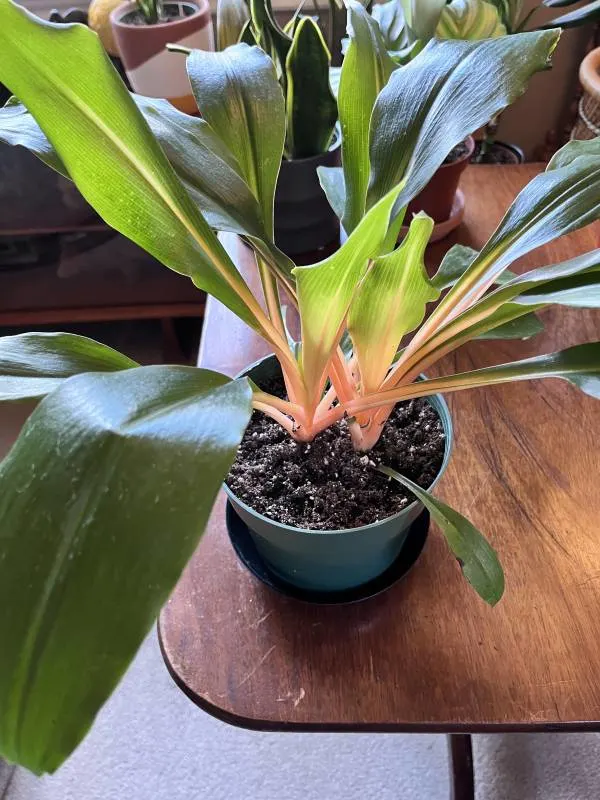
6. Green Spider Plant
The elusive beauty of the solid Green spider plant boasts lush, glossy green leaves, without creamy or light yellow stripes, setting it apart from its more common variegated spider plants.
While it might be a bit rare and slightly pricier, nurturing it is a breeze.
As it matures, it even surprises you with delicate green flowers.
Interestingly, after 1970, commercial production of the Green spider plant stopped, but fear not!
If you even have one Green spider plant, you can multiply your collection through propagation.
Characteristics
Let’s look at some plant characteristics:
Size: The Green spider plant typically grows to a height of about 12 to 18 inches (30 to 45 cm) and spreads up to 24 inches.
Light Requirement: Provide bright, indirect light for optimal growth.
Soil Requirement: Just plant it in well-draining soil, keeping the moisture level balanced – not too dry and certainly not waterlogged.
Unlock the allure of this unique spider plant and enjoy its green charm in your garden.
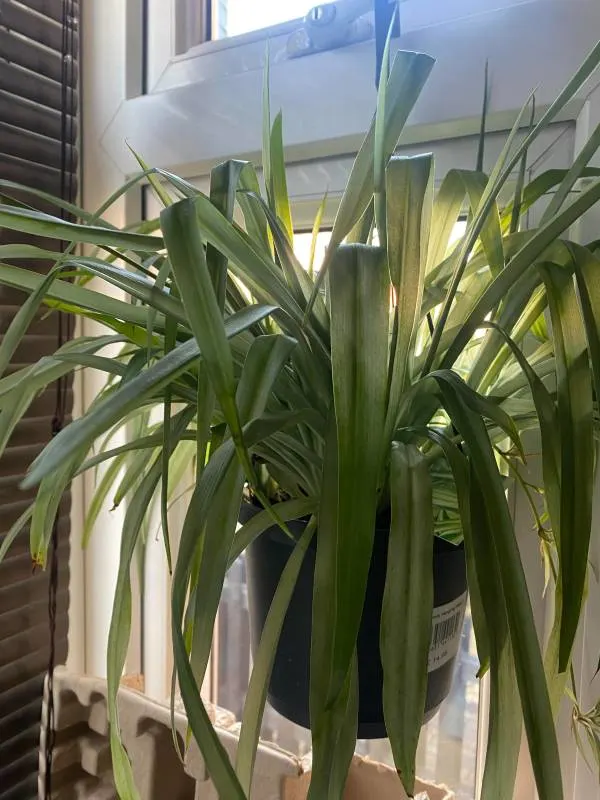
7. Golden Nugget Spider Plant
Chlorophytum comosum ‘Gold Nugget,’ commonly known as the Golden pothos or Golden spider plant, is a popular and visually striking houseplant known for its stunning variegated foliage.
Gold Nugget stands out due to its arching, slender, green leaves adorned with striking yellow or golden stripes, creating an attractive contrast and making it a sought-after choice for indoor gardening enthusiasts.
This cultivar is known for its ability to produce offsets or “spiderettes” – small plantlets that dangle from long, arching stems. These can be easily propagated to create new plants.
So, you can easily expand your ‘Gold Nugget’ collection and share it with your friends and family.
Characteristics
Here are a few plant characteristics:
Size: Gold Nugget spider plant typically grows to a height of around 8 to 12 inches.
Soil: This plant prefers well-draining potting soil, such as a mix of peat-based or loamy soil with perlite or sand to aid in drainage.
Light Requirement: Gold Nugget thrives in moderate to bright light but can tolerate lower light conditions as well.
Adding a touch of nature’s elegance to your indoor space, ‘Gold Nugget’ is not just a houseplant; it’s a botanical masterpiece waiting to be admired.
8. Hawaiian Spider Plant
The Hawaiian spider plant, also known as the Golden Glow or Golden Light plant, is a captivating houseplant originating from the beautiful island of Hawaii.
Its unique appearance, featuring bright green leaves with a distinctive yellow stripe down the middle, sets it apart from its spider plant cousins.
Keeping your Hawaiian spider plant happy is a breeze.
It adds a touch of tropical beauty to your space while staying compact and manageable.
Characteristics
Following are some plant characteristics:
Size: This charming spider plant doesn’t grow too tall, reaching a maximum height of 12 inches, making it perfect for cozy corners in your home.
Light Requirement: It’s incredibly easy to care for, requiring only bright, indirect light.
Soil Requirement: Requires well-draining, slightly moist soil.
Give it the care it deserves, and your Hawaiian spider plant will be your home’s radiant green companion, brightening up your living space.
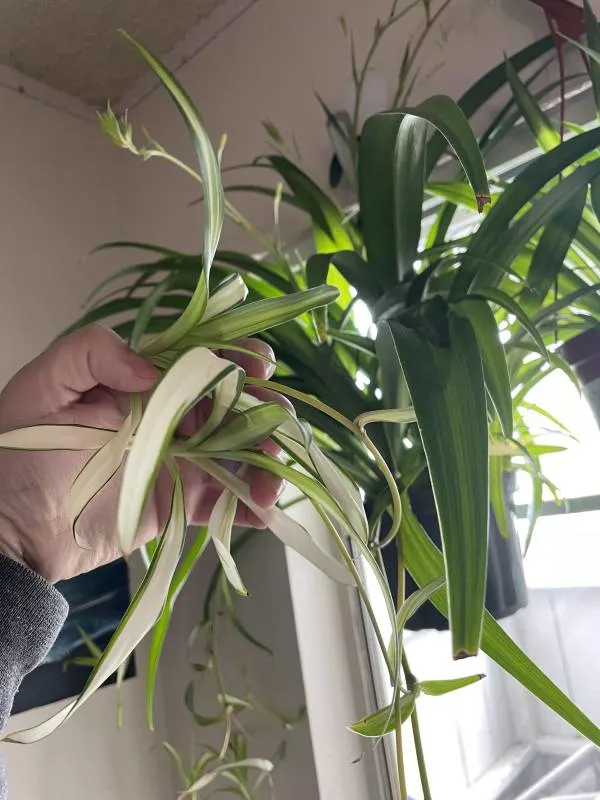
9. Lemon Spider Plant
Chlorophytum comosum ‘Lemon,’ also commonly known as the Lemon Spider Plant, is a popular and attractive cultivar of spider plant varieties.
This very rare spider plant variety is celebrated for its distinctive foliage, which sets it apart from other spider plants.
One of the most striking features of the ‘Lemon’ variety is its long, arching leaves, which are primarily green but adorned with broad stripes of lemon-yellow or creamy white along the edges.
This unique coloration gives the plant a bright and cheerful appearance that instantly adds a touch of freshness to any indoor space.
Characteristics
Here are a few plant characteristics:
Size: It is a moderate-sized houseplant, typically reaching a height of about 12 to 18 inches and spreading to a width of 12 to 24 inches.
Soil Requirement: A standard indoor plant potting mix with good drainage properties is suitable. You can also add perlite or sand to the mix to enhance drainage.
Light Requirement: The Lemon variety requires moderate to bright indirect light; avoid direct sunlight to prevent leaf damage.
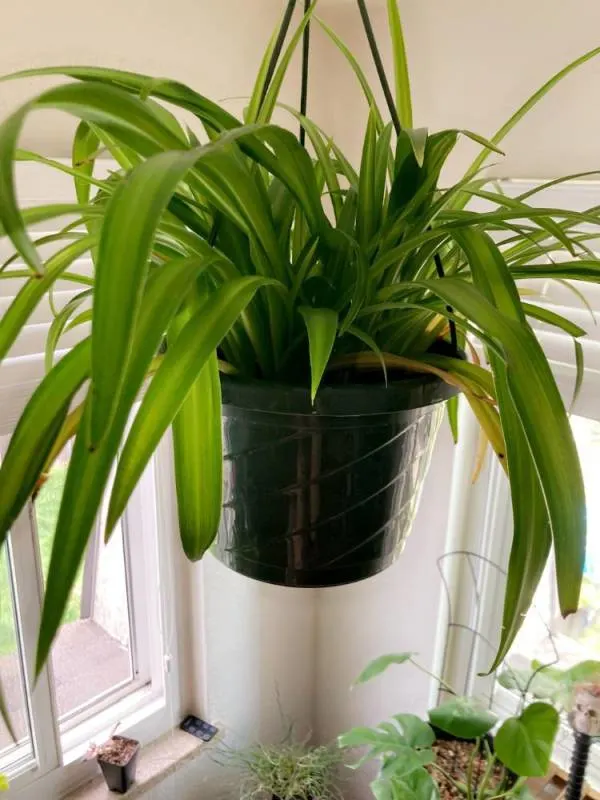
10. Ocean Spider Plant
The Ocean spider plant is a charming addition to any indoor garden.
The leaves of the Ocean spider plant resemble the rolling waves of the ocean, with delicate green margins and a creamy white center.
This compact houseplant doesn’t demand much attention, making it perfect for busy folks.
As a bonus, this lovely plant produces dainty star-shaped white flowers. It looks particularly enchanting when displayed in a hanging basket.
Characteristics
Let’s look at some plant characteristics:
Size: It reaches a mature height of about 18 inches and a width of 12 inches.
Light Requirement: To keep it thriving, place it where it can enjoy bright, indirect sunlight.
Soil Requirement: When growing spider plants, make sure the soil is well-draining and slightly moist, especially during the warmer months.
Bring a touch of the ocean’s beauty to your home with the Ocean spider plant.
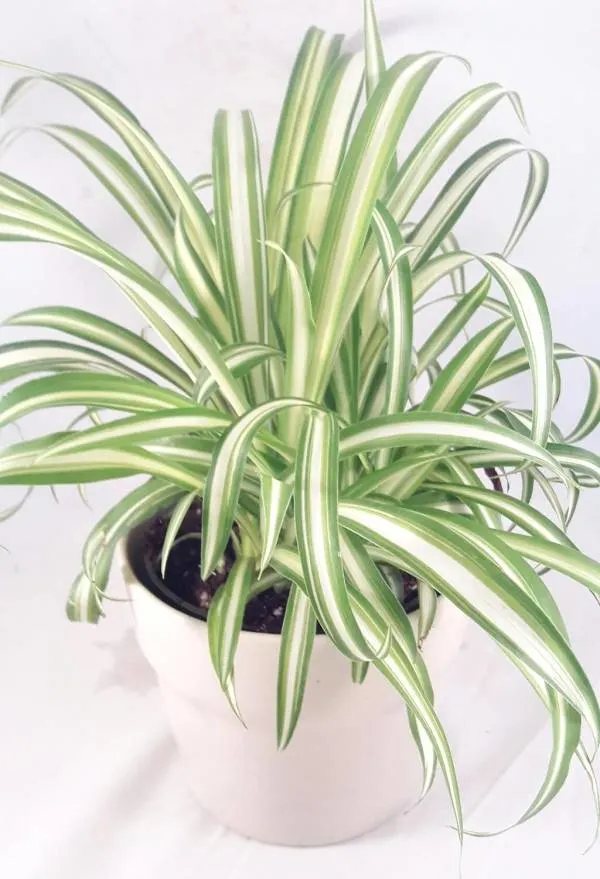
11. Purple Spider Plant
The Purple Spider Plant, also known as the Violet Queen or Spider Flower plant, is a fast-growing annual plant that hails from regions like southeast Brazil, Uruguay, Paraguay, and Argentina.
Though it’s not a true member of the spider plant family, it’s often thought of as one.
What makes it truly captivating are its fragrant, rich violet flowers, which can also be found in white or pink variations. Each flower boasts six stamens and four petals, making them a sight to behold.
Its aromatic, palmate-shaped leaves add to its charm, especially during the cold season when it showcases its beautiful blooms.
Characteristics
Here are a few plant characteristics:
Size: This lovely plant can reach heights of up to 3 to 4 feet and spreads 1 to 2 feet.
Light Requirement: To thrive, the Purple spider plant craves direct sunlight.
Soil Requirement: Needs well-draining soil to grow healthy and wealthy.
Embrace the allure of the Purple spider plant and bring a touch of vibrant beauty to your space.
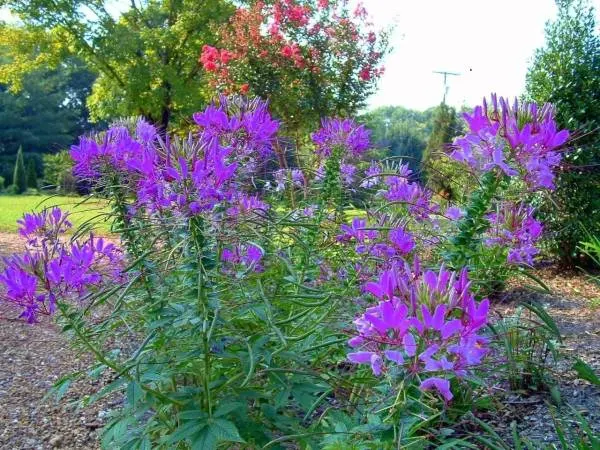
12. Zebra Spider Plant
The Zebra Grass spider plant is a striking addition to your indoor garden.
Its leaves are like a miniature grassy meadow, featuring long yellow-cream blades with a bold green stripe down the center.
Unlike a zebra’s black and white stripes, this plant’s hues are more subtle, creating a unique and elegant look. If you’re seeking a touch of vertical design, this spider plant is your go-to.
Plus, it’s a pro at producing baby plants from its stems, making it an ideal candidate for propagation.
Characteristics
Following are a few plant characteristics:
Size: Native to tropical Africa, it grows quickly, with mature leaves reaching up to 22 inches in length.
Light Requirement: The Zebra Spider plant requires bright, indirect light.
Soil Requirement: This plant requires well-draining, peat-based soil to thrive well.
So, whether you’re a seasoned plant enthusiast or just starting out, the Zebra Grass spider plant has got you covered.
FAQs
Here are the answers to some frequently asked questions:
Are All Spider Plant Varieties Easy to Care For?
Yes, the majority of spider plant varieties are known for their ease of care.
They are generally forgiving and adaptable to various indoor conditions. Their tolerance for low light, minimal watering, and resistance to pests make them ideal for beginners.
However, while most spider plants are easy to care for, specific care requirements may vary slightly among different varieties, so it’s essential to familiarize yourself with the needs of your chosen type for optimal growth.
Can Spider Plants Be Grown Outdoors, or Are They Strictly Indoor Plants?
Spider plants can be grown outdoors in suitable climates.
They thrive in mild temperatures, partial shade, and well-draining soil. However, they are often grown as houseplants in regions with harsh winters or extreme heat.
Are Spider Plants Toxic to Humans and Pets?
Spider Plants (Chlorophytum comosum) are non-toxic to humans and most pets, including cats and dogs.
They are considered safe in homes where pets or children are present.
However, while spider plants are generally harmless, some individuals may have mild allergic reactions when in contact with the plant’s sap or leaves.
So, it’s advisable to keep the plant out of reach to prevent ingestion or excessive handling.
That’s all for today!
With that said, let’s head toward the conclusion.
Conclusion!
In a world of endless choices, spider plants stand out as the perfect green companions for your indoor spaces. With their striking leaves, air-purifying magic, and easy care, these plants are a win-win for everyone.
From the unique Airplane spider plant to the elegant variegated Bonnie spider plant and the vibrant Fire Flash spider plant, there’s a spider plant for every style and space.
They effortlessly add charm, freshness, and a touch of nature to your home.
So, why wait?
Bring the captivating allure of spider plants into your life today!
Regards,
Moiz Atiq.
